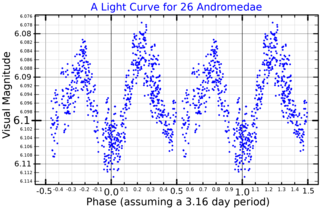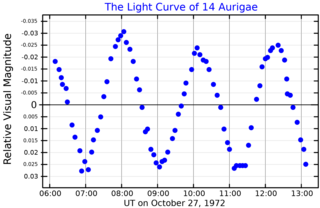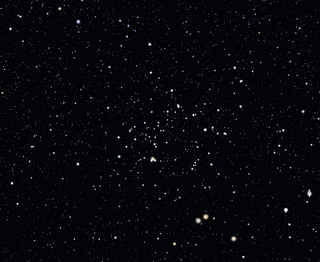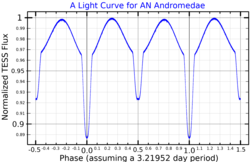
Beta Trianguli is the Bayer designation for a binary star system in the constellation Triangulum, located about 127 light years from Earth. Although the apparent magnitude is only 3.0, it is the brightest star in the constellation Triangulum.

Zeta Andromedae is a star system in the constellation Andromeda. It is approximately 189 light-years from Earth.

28 Andromedae is a Delta Scuti variable star in the constellation Andromeda. 28 Andromedae is the Flamsteed designation. It also bears the variable star name GN Andromedae. Its apparent magnitude is 5.214, varying by less than 0.1 magnitudes.

26 Andromedae, abbreviated 26 And, is a binary star system in the constellation Andromeda. 26 Andromedae is the Flamsteed designation. It has a combined apparent visual magnitude of 6.10, which is near the lower limit of visibility to the naked eye. The distance to this system can be estimated from its annual parallax shift of 5.35 mas, which yields a distance of about 600 light years. At that distance, the visual magnitude of the stars is diminished from an extinction of 0.04 due to interstellar dust. The system is moving further from the Earth with a heliocentric radial velocity of +3.3 km/s.
66 Andromedae is a binary star system in the northern constellation of Andromeda, near the northern border with Perseus. The designation is from the star catalogue of English astronomer John Flamsteed, first published in 1712. It has a combined apparent magnitude of 6.16, which is near the lower limit of stars that are visible to the naked eye under good seeing conditions. An annual parallax shift of 18.3 mas provides a distance estimate of 178 light years. The net radial velocity of the system is poorly constrained, but the pair appear to be moving closer to the Earth with a heliocentric radial velocity of around −5 km/s.

14 Aurigae is a quadruple star system located 269 light years away from the Sun in the zodiac constellation of Auriga. It has the variable star designation KW Aurigae, whereas 14 Aurigae is the Flamsteed designation. It is visible to the naked eye as a faint, white-hued star with a combined apparent visual magnitude of 5.01. The system is moving closer to the Sun with a heliocentric radial velocity of −9 km/s.

31 Camelopardalis is a binary star system in the northern circumpolar constellation of Camelopardalis. It is visible to the naked eye as a dim point of light with a peak apparent visual magnitude of +5.12. Parallax measurements provide a distance estimate of approximately 460 light years away from the Sun, and the system is drifting closer to the Earth with a radial velocity of −3 km/s.
3 Centauri is a triple star system in the southern constellation of Centaurus, located approximately 300 light years from the Sun. It is visible to the naked eye as a faint, blue-white hued star with a combined apparent visual magnitude of 4.32. As of 2017, the two visible components had an angular separation of 7.851″ along a position angle of 106°. The system has the Bayer designation k Centauri; 3 Centauri is the Flamsteed designation. It is a suspected eclipsing binary with a variable star designation V983 Centauri.

ET Andromedae is a binary star system star in the northern constellation of Andromeda. It has an apparent visual magnitude of 6.48, placing it at the nominal limit for visibility with the naked eye. The distance to this system can be estimated from its annual parallax shift of 5.42 mas, which yields a value of 602 light years.

HD 21278 is a binary star system in the constellation Perseus, located within the 60±7 million year old Alpha Persei Cluster. It has a blue-white hue and is visible to the naked eye with a combined apparent visual magnitude of 4.99. The system is located at a distance of approximately 580 light years from the Sun based on parallax, and it is drifting further away with a radial velocity of +1.20 km/s.

14 Lacertae is a binary star system in the northern constellation Lacerta, located around 1,600 light years away. It has the variable star designation V360 Lacertae; 14 Lacertae is the Flamsteed designation. The system is barely visible to the naked eye in good seeing conditions, having a peak apparent visual magnitude of 5.91. It is moving closer to the Earth with a heliocentric radial velocity of −16 km/s.

Chi2 Hydrae, Latinised from χ2 Hydrae, is a binary star system in the equatorial constellation of Hydra. Based upon an annual parallax shift of 4.6 mas as seen from Earth, it is located roughly 685 light years from the Sun. It is visible to the naked eye with a combined apparent visual magnitude of about 5.7.

42 Persei is a binary star system in the northern constellation of Perseus. It has the Bayer designation n Persei, while 42 Persei is the Flamsteed designation. The system is visible to the naked eye as a dim, white-hued point of light with an apparent visual magnitude of 5.11. It is located around 93 parsecs (302 ly) distant from the Sun, but is drifting closer with a radial velocity of −12.4 km/s.

16 Lacertae is a triple star system in the northern constellation of Lacerta, located about 1,580 light years from the Sun. It has the variable star designation EN Lacertae; 16 Lacertae is the Flamsteed designation. This system is visible to the naked eye as a faint blue-white hued star with a maximum apparent visual magnitude of +5.587. It is moving closer to the Earth with a heliocentric radial velocity of –12 km/s.
λ Librae is the Bayer designation for a binary star system in the zodiac constellation of Libra. It can be faintly seen with the naked eye, having an apparent visual magnitude of 5.03. With an annual parallax shift of 10.54 mas, it is roughly 310 light years from the Sun. At that distance, the visual magnitude of this system is diminished by an extinction factor of 0.22 due to interstellar dust. It is 0.1 degree north of the ecliptic.

DS Andromedae is an eclipsing binary star in the constellation Andromeda and a member of the open cluster NGC 752. Its maximum apparent visual magnitude is 10.44, but drops down to 10.93 during the main eclipse and to 10.71 during the secondary one.
KX Andromedae is a spectroscopic binary star in the constellation Andromeda. Its apparent visual magnitude varies between 6.88 and 7.28.

DH Cephei is a variable binary star system in the northern circumpolar constellation of Cepheus, positioned about two degrees to the east of the star system Delta Cephei. With an apparent visual magnitude of 8.61, it is too faint to be visible without a telescope. Based on parallax measurements, this system is located at a distance of approximately 9.6 kilolight-years from the Sun. At present it is moving closer to the Earth with a radial velocity of −33 km/s.

HS Hydrae is a triple star system in the equatorial constellation of Hydra. The inner pair were an eclipsing binary during the period 1920 until 2019, with HS Hya being the variable star designation. With a base apparent visual magnitude of 8.08, HS Hya is too dim to be viewed with the naked eye. During the primary eclipse, the magnitude dropped to 8.61; the secondary eclipse lowered the magnitude to 8.55. Based on parallax measurements, the system is located at a distance of approximately 335 light years from the Sun. It is drifting closer with a mean radial velocity of −7 km/s.

HU Tauri is a tight binary star system in the equatorial constellation of Taurus. It is an eclipsing binary, which means that the member stars periodically eclipse each other every 2.056 days. They have a combined apparent visual magnitude of 5.85, which is bright enough to be dimly visible to the naked eye. During the primary eclipse, the magnitude drops to 6.68, while the secondary eclipse decreases the magnitude to 5.91. The distance to this system, based on parallax measurements, is approximately 414 light years.















